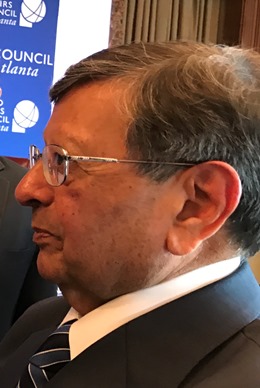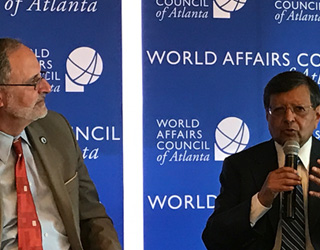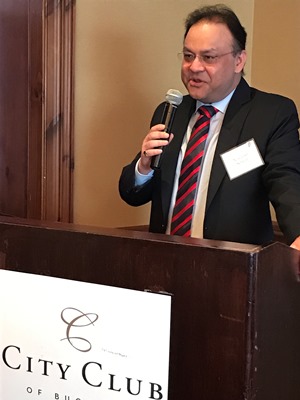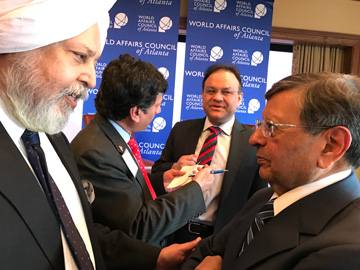India: A Progress Report by Dr. Jagdish Sheth

(Left) Dr. Jagdish Sheth. (Photo: Geeta Mehrotra)
A year ago Jag Sheth impressed us with his vision of where India would be in 2026 — if it followed the right economic and social policies. On February 21, 2017, at the elegant City Club of Buckhead, the World Affairs Council of Atlanta (@WACATL) hosted Dr. Sheth for his one-year progress report.
Is the government of Prime Minister Narendra Modi on track to realize India’s enormous economic and political potential? How will U.S.-India relations prosper in the Trump administration? Where are there synergies and potential pitfalls in the bilateral relationship?

Ambassador Charles Shapiro, President of World Affairs Council of Atlanta with the speaker, Dr. Jagdish Sheth. (Photo: Geeta Mehrotra)
The main dining room was packed with an audience from all walks of life: businessmen, lawyers, students from Georgia State University, community members of both American and Indian origin. A warm welcome from the moderator, Ambassador Charles Shapiro, President of WACATL, set the tone.

(Right) Consul General Nagesh Singh introduced Dr. Sheth. (Photo: Geeta Mehrotra)
Consul General Nagesh Singh thanked the hosts for providing the best advocate for India: Dr. Jagdish Sheth. Mr. Singh encouraged the students present to study the importance of the world’s 5th largest economy in real terms and 3rd largest economy in terms of purchasing power parity, a country with 1/6th of the world population, and the largest democracy.
Partnership with the USA is essential, he said, for India’s transformation and also as a partner for global solutions. India will lead and be part of providing solutions to global challenges such as environment and terrorism. We must understand each other better, for gone are the days when walls and oceans protect from competition.
Dr. Jagdish Sheth, Kellstadt Professor of Marketing at Goizueta Business School, Emory University, is an academician, philosopher, practitioner, author, and speaker. He presented India’s progress report as heading in the right direction.
|
Based on purchasing power parity (PPP), by 2020, China will surpass the US economy and will remain number one. However, by 2050, India will become the second largest economy surpassing the United States. Similarly, Indonesia will become the fourth largest economy, surpassing Japan. Two major events took place in 2016. The first was the demonetization of the Indian Rupee and the second was the unpredictable victory of Donald Trump as President of the United States. Demonetization was long overdue and necessary, because after the liberalization of the Indian economy in 1991, there was an unprecedented growth of private income and private wealth. India produced hundreds of thousands of millionaires and a few billionaires. However, most of the new income and wealth did not pay income tax. The Indian economy grew as a cash-based economy and by 2016, it was as large as 35 percent of total economy. This cash-based consumption also avoided paying indirect taxes such as sales and service tax. More importantly, this “hot money” was used to pay politicians and bureaucrats as well as for funding illegal activities. Furthermore, wealth generated in India began to exit the country through the Hawala transactions. The country was starved of its own wealth to be invested for further domestic growth. There will be three consequences as the nation begins to become a cashless economy. First, it will generate more recorded transactions and therefore, more tax collection. Second, the nationalized government banks will increase their deposits substantially. They need it badly because of poor loans made in the past, resulting in large amounts of “nonperforming assets” (NPA) on their books. Finally, India’s economy is based on contract work. It is estimated that more than 90 percent of the workers are contract labor due to its labor laws. This contract work is paid in cash whether they are tenant farmers, factory workers, service employees, or maids, cooks, or drivers at home. They, in turn, buy daily necessities of food, shelter, and clothing with cash and therefore, do not contribute through consumption tax. With the Universal Digital Identification System (UDIS), today more than a billion people in India have a biometric identification and therefore they can become digital consumers and employees. This will transform the informal economy to an organized economy. As I have mentioned before, India has size but no scale. This will create scale across most consumer sectors. The best example is the unprecedented success of Reliance Jio, which signed up more than 100 million subscribers of its wireless service in six months. This demonetization and cashless economy will bring more transparency and will result in attracting foreign investments from advanced nations who use less cash and more credit cards, checks, or online payments. The second major event of 2016 is Donald Trump’s election. Fundamentally, the Trump Presidency will shift multilateral trade to bilateral trade, which will open the U.S. market for India. Also, the Trump Presidency will shift the policy from trade to investment all over the world. Since India is such a large consumer market for cell phones and consumer electronics to automobiles, motorcycles, and scooters to entertainment, education, and health services, there will be much greater investing in India. This will enhance the investment in India and especially in defense, infrastructure, and consumer markets. Ironically, if Make in India initiative is focused on manufacturing, it will succeed in services such as IT services, research and development, engineering, and academic, legal, and other professional services because India has a very large pool of talented people in professional services. It will become a global hub for services. A recent example of this capability is the successful launch of 120 satellites in one single launch, clearly demonstrating that “India’s got talent.” The Trump Presidency will encourage many multinationals such as Microsoft, Intel, Google, and others to invest in their own development centers as well as BPOs, to serve the rest of the world from India, as the U.S. visa policy becomes more punitive and cumbersome. In my opinion, Dr. Sheth said, the Trump Presidency will also attract Indian capital to invest in America through acquisition of midsized companies. Overall, India will become more strategic to the U.S., not because of its domestic market, but as a geopolitical force to counter-balance China, as well as become a track for meetings between the U.S. and the Middle East. Just to remind all of us, it was the Indian Embassy in Washington which became a meeting place after Egypt broke off diplomatic relations with the US. Both nations met at the Indian Embassy to restart the dialogue. India’s deep diplomatic relationship with Egypt, Turkey, Japan, and Myanmar as well as Russia will be invaluable for the U.S. diplomacy. |
After questions from the audience and closing remarks by Fernanda Luchine, Program Director, World Affairs Council, Dr. Sheth took the time to meet everyone who wanted to talk to him.

(Left) Teji Sahni speaks to Dr. Jagdish Sheth; in the background: Manoj Bhatia and Consul General Nagesh Singh.
(Photo: Geeta Mehrotra)
Enjoyed reading Khabar magazine? Subscribe to Khabar and get a full digital copy of this Indian-American community magazine.









